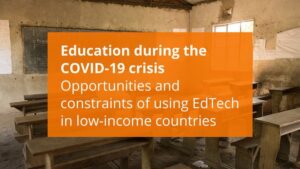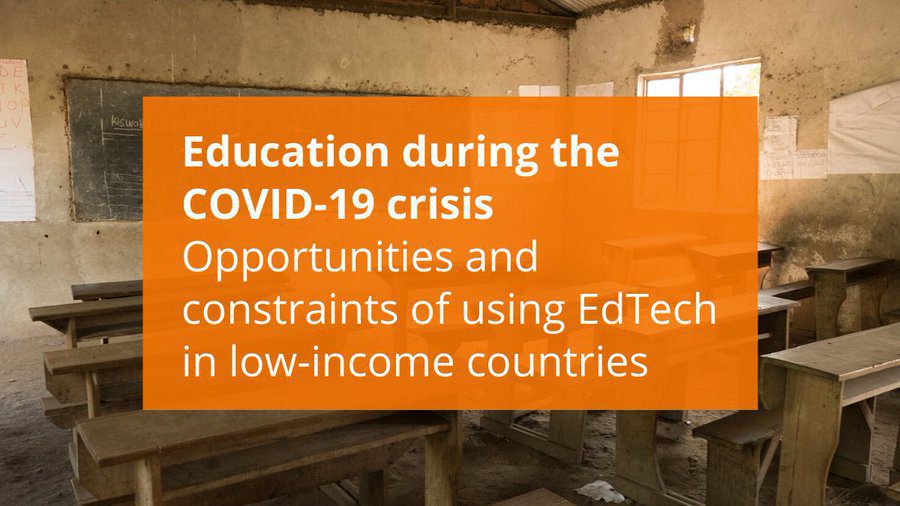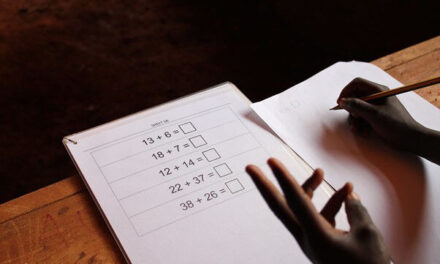This policy brief is a collaboration between the EdTech Hub and Digital Pathways at Oxford, Blavatnik School of Government. It was written by Raluca David, Digital Pathways at Oxford, Blavatnik School of Government; Arnaldo Pellini, EdTech Hub, Overseas Development Institute; Katy Jordan, EdTech Hub, University of Cambridge; and Toby Phillips, Digital Pathways at Oxford, Blavatnik School of Government. This summary was originally published on the EdTech Hub website on 15 April 2020.
Key messages from Policy Brief
- During this time of crisis, education will not be business-as-usual, and EdTech alone cannot close the learning gap. It will be dedicated teachers and resilient educators who will ensure learning doesn’t stop — but they could be helped by the right EdTech tools
- The digital divide means that internet and mobile network access varies greatly in middle- and low-income countries
- Governments can provide immediate support by informing teachers about simple grassroots platforms where they can share their own EdTech solutions
- Educational television and radio broadcasts in combination with SMS are effective communication channels between educators and students when the internet connectivity is poor or not available
- It will be important for education authorities to begin planning how in 12 months’ time they will diagnose and treat the learning gaps that have emerged during the crisis
School closures and COVID-19
 School closures due to coronavirus (COVID-19) are affecting learners worldwide. By the end of March 2020, over 180 countries had closed down their schools, affecting 87.4% of learners (over 1.5 billion students, see fig.1). Governments are taking action to support learners to continue their education remotely. Some are using technology, but they face a number of challenges as they also deal with country-wide healthcare emergencies and likely economic recession.
School closures due to coronavirus (COVID-19) are affecting learners worldwide. By the end of March 2020, over 180 countries had closed down their schools, affecting 87.4% of learners (over 1.5 billion students, see fig.1). Governments are taking action to support learners to continue their education remotely. Some are using technology, but they face a number of challenges as they also deal with country-wide healthcare emergencies and likely economic recession.
We know that school closures due to health crises such as Ebola outbreaks impact learners. They lead to more school dropouts, leave learners at a higher risk of abuse, loss of confidence and self esteem, and decline in quality teaching and learning.
In this brief, Digital Pathways and The EdTech Hub examine the key constraints of using EdTech at scale at a time of crisis, and highlight the opportunities that have so far emerged, in a rapidly-changing context. We provide evidence and examples to inform policy and programming decisions.
Figure 1: Percentage of students affected by COVID-19 school closures, global
Key moments:
- 21 February: China closes schools nationwide
- 12 to 16 March: Number of countries closing schools nationwide increases from 37 to 112
- 21 March: 168 countries adopt country-wide school closures
- 30 March: Country-wide school closures in 181 countries involve 87.4% of the global enrolled learners
What are the key constraints for using EdTech at scale?
During this time of crisis, education will not be business-as-usual, and EdTech alone cannot close the gap. Education policymakers must be realistic — with or without EdTech, usual targets of learning will not be achieved. However, there is much that can be done, both to advance learning now, and to be better prepared to return to classrooms when school closures end; allowing teachers and learners to pick up from where learning will have got to and address gaps that will have emerged.
To this end, countries need to manage their expectations of what can be done over the next weeks and months, by identifying the key constraints to educating learners remotely. Large investments in EdTech will deliver few results if not based on clear assessment of the limitations of the system.
The movement to out-of-school learning will exacerbate already weak education management and data collection systems
There is a reasonable amount of evidence in aggregate about the effects of school closures. For example it seems that numeracy and mathematics progression is particularly affected. What we know less about is whether distance learning and EdTech can help offset these negative consequences. Most education systems around the world are decentralised which offers an opportunity to experiment with innovation and learn about different approaches. It also presents the challenge of delegating decision-making authority. A core constraint, however, is the availability of local data and information to inform this decision-making. Without an operating footprint of schools to channel information up and down, policymakers have to be realistic. They are likely to have less information than what is normally available from weak education management and data collection systems meaning they will be unable to optimise their decisions.
Students’ progression against formal curriculums will slow down
Country-wide school closures have happened very rapidly, leaving very little or no time for schools to prepare a strategy and transition to distance learning. Syllabuses which are exam-oriented are no longer fit for purpose as tests and examinations have been put on hold. Much of the curricula cannot be adapted quickly to teaching online and students face the anxiety of not knowing how their school year will progress. As a result, exam-orientated progress will slow down for all learners. Certain groups of learners may be particularly affected such as primary school learners who are building the foundations for later learning, vulnerable learners or those supported by adults who often have not had access to a formal education themselves.
Many children will not have access to technology or a suitable learning environment at home
The digital divide means that internet and mobile network access varies greatly in low-income countries, for instance access to the internet is over 80% of the population in some Southeast Asian countries, but as low as 39% in Vietnam and some African countries. The reality is that online learning will be easier for those with access and will exclude large groups of disadvantaged learners. A large number of learners may have no electricity, some will have a radio but not a television at home, others will have basic feature mobile phones but not smartphones, and others will have only low-bandwidth internet available.
Teachers’ ability to adapt to delivering education remotely will vary greatly
Some teachers will champion video conference lessons, keep in touch with their students on social media or SMS messaging and produce teaching materials. Others may feel overwhelmed if they are suddenly required to use technology new to them, and if they are held accountable to new standards. Education system managers must be aware of their teachers’ levels of ability and set expectations accordingly. EdTech might remedy some of this — for instance through flexibly adapting materials to different technological channels of delivery or opening up channels to rapidly support struggling teachers through mentoring by teachers’ educators — but teacher capability will be a core constraint, and cannot be quickly overcome.
What are the opportunities of EdTech?
EdTech can help mitigate the effects of the educational crisis, but alone it is not the solution, and it will be difficult to scale up in a short time frame. This is not the right time to invest heavily in new hardware, or entirely new curricula. Rather, we highlight what can be done within current constraints, with resources readily available, and with minimum levels of investment. We describe solutions that can improve outcomes in the short term (within weeks after school closures), and in the longer term (within one year, either while schools are still closed still, or when countries will need to address the learning gaps that have emerged). The solutions that we describe also represent some areas of support that teachers will need during the transition to distance learning in terms of knowledge and instruction skills. Ultimately, it will be dedicated teachers and resilient educators who will make sure learning doesn’t stop — but they can be helped by the right EdTech tools.
Within weeks
A simple grassroots platform where teachers can share their own EdTech solutions can be a quick start
One example is DIKSHA in India, a platform that has created a community of practice over recent years, hosting lesson plans and supporting materials uploaded by teachers and curated by a central authority. The platform can help level the variable abilities of teachers to use EdTech, and can multiply the efforts of ‘champion’ teachers who create resources in local languages for local curricula. This can be complemented by tools that also provide direct feedback to teachers, such as the Tusome platform in Kenya which helped bridge learning gaps in resource-constrained settings where teachers struggled to reach targets. In the COVID-19 context, teachers should be encouraged to share solutions that work on the internet, but low-tech solutions could be as simple as connecting small networks of isolated teachers by SMS.
Broadcasting lessons through radio or television may help reach isolated students without internet access
By making use of existing infrastructure and cheaper technology, initiatives can be set up quickly, at scale and with little investment. Educational television and radio provision have demonstrated benefits to learning for early days and primary school. Television lessons are already being used in Kenya in response to the current crisis, but there are wider examples for reference, from the classic Sesame Street to local programmes such as Know Zone in Kenya, and Ubongo Kids in Tanzania. Similarly, radio-based instruction was used during periods of school closures during Ebola outbreaks. The one-way transmission of information by radio or television can potentially be supplemented by communication using mobile phones. Broadcasts have been used in combination with SMS to communicate between educators and students, as well as peer networks of students. The popularity of WhatsApp in low- and middle-income countries may lend itself to quickly form such groups. There are also EdTech apps being designed to work through basic feature phones and SMS messaging (such as textTETEA in Tanzania or Eneza Education in Kenya, Ghana and Cote D’Ivoire) – and these will have a much broader reach than smartphone and tablet apps. While television and radio lessons can have an immediate impact, countries should also learn from what works now and invest in producing television and/or radio materials to be prepared if schools remain closed the long term or for future crises.
Another useful response is to create an online one-stop-shop of resources that students can access directly or with the support of their parents
Educational resources are already available on the internet, such as the Khan Academy. A wide range of open educational resources are freely available; distance courses for school-aged learners published under open licences such as British Columbia Open School may be rapidly repurposed. But policymakers must understand that online resources vary in quality and are rarely designed for local curricula, culture or language. Countries should invest in their own free resources for students and families and draw on partnerships with alternative or non-formal providers to help strengthen digital learning materials — both in the immediate term and for long term preparedness. As noted above, providing only content that requires high bandwidth (such as videos) will not achieve much where access is limited. Rather, content will need to run on low bandwidth, offline or be accessible on basic feature mobile phones (the primary means to access the internet in many low-income countries).
Within one year
Education through technology can be ‘gamified’ to maintain learning over longer school closures
The risk in the longer-term is that students will lose interest especially when parents do not have capacity to motivate them. Countries and teachers directly can apply game-like elements to lessons and assignments, both online and on television and radio. This could include the addition of points, achievement badges or competitive leaderboards. There is emerging evidence that ‘gamification’ can be effective. The simple message is that providing worksheets and syllabus books will achieve little by itself – a key part of the role of the teacher and the school environment is about motivating students. Remote learning solutions must try to fill this motivation gap. Meanwhile, countries should also foster a shared identity that benefits learning. For instance highlighting that it is crucial at this time for all to work together to overcome the danger of a generation losing out on their education and future economic prospects.
To cope with the educational crisis, within the next year policymakers will need essential data
Currently, countries do not have a sense of how to reach every child (what technology is available within each household), where the gaps are (how much each child has fallen behind), what is effective (what EdTech works in their local context: local-level solutions that schools, communities, and teachers designed to support the provision of education during the crisis) and what can improve equity (to overcome persistent problems of access to education). One way to effectively gather data would be to use mobile phone-based apps where teachers can report information about the progress and needs of their students – and the app would then collate and display this data geographically. Already, UNICEF is mapping connectivity of schools worldwide – but the next step is to map the connectivity and learning needs of every student. When doing so, countries should plan to set good data standards across the system, to ensure compatibility, to match any microservices they acquire to their data systems, and to provide the right governance of data for their context, including data privacy considerations.
In one year’s time, having the right technology to ‘diagnose and treat’ learning gaps that have emerged during the crisis will make a substantive difference
Digitalised personalised learning software already helps bridge learning gaps in low-income countries. Mindspark improved learners’ scores in maths by 38% in India over 4.5 months. These tablet-based apps assess students’ current level and give personalised lessons and exercises. They may also help gender disparities in learning. One such initiative ‘onecourse’ prevented a gender gap in reading and mathematics from surfacing amongst first-graders in Malawi. Countries need to start thinking now about taking action to stop emerging gaps. To do this they must focus on how to acquire the right technology, adapt it to the local context and start rolling it out in phases, guided by feedback (Central Square Foundation gives guidance on these processes). The good news is that once scaled up, these technologies can become relatively inexpensive.
Acknowledgements
Funding to produce this policy brief has been provided by the UK’s Department for International Development. This policy brief is a joint publication between the EdTech Hub and Digital Pathways at Oxford, Blavatnik School of Government. The analysis presented in this brief is that of the authors alone.
The authors would like to thank Bob Moon, Michael Trucano and Susan Nicolai for providing comments to the draft of the brief. We want to thank also Briony Gould, Elina Lehtomäki, Elizabeth Stuart and Thomas Davies for their suggestions and support.
Licence
Creative Commons Attribution 4.0 International
You are free to share (copy and redistribute the material in any medium or format) and adapt (remix, transform, and build upon the material) for any purpose, even commercial ones. You must give appropriate credit, provide a link to the license, and indicate whether any changes were made. You may do so in any reasonable manner, but not in any way that suggests the licensor endorses you or your use.






